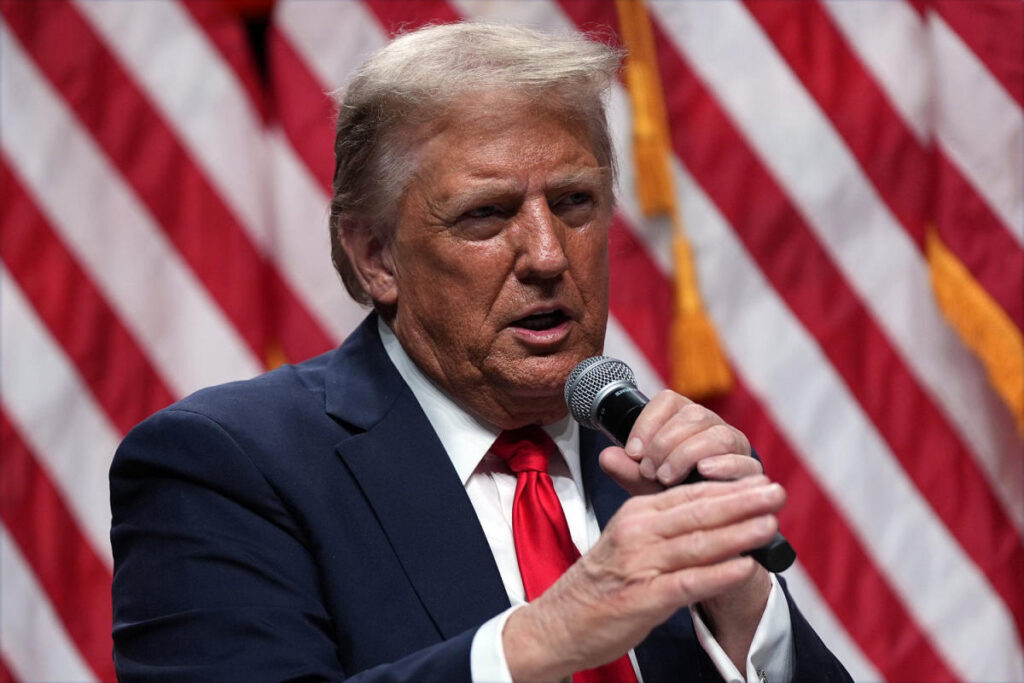In Glendale, Arizona, former President Donald Trump delivered a combative performance at a rally just days before Election Day, where he targeted his opponents with scathing remarks and his characteristic provocative rhetoric. Seated beside right-wing media figure Tucker Carlson, Trump vented his frustrations about President Joe Biden, whom he dismissed as “a stupid bastard,” and Vice President Kamala Harris, labeling her “a sleaze bag.” Among his more controversial statements was a suggestion regarding Liz Cheney, a prominent Republican critic, implying that her views on military conflicts would change if she were threatened in a war scenario. This violent imagery underscored the aggressive tone Trump has taken against those opposing him, reflecting the strained dynamics within the Republican Party, particularly following the January 6 Capitol riot, where Cheney’s criticisms and her father’s historical involvement in military affairs have made her a target for Trump’s ire.
The former president’s attacks on Cheney were pointed and laced with violent undertones, illustrating a broader trend of Trump’s bellicose language towards political adversaries. He accused her of being a “radical war hawk” and suggested that her perspective would be different were she in a life-threatening situation. Trump’s spokesperson later defended these comments as a critique of Cheney’s propensity to advocate for military actions while staying safely distanced from potential warfare. This narrative of “cheating” in the electoral system emerged as Trump claimed that he would only face defeat if the election were marred by dishonesty, fostering a framework for potential contestation of results that could alter the electoral landscape.
In response to Trump’s incendiary statements, particularly regarding Cheney, the backlash was swift. Cheney herself took to social media, comparing Trump’s threats to tactics used by dictators to suppress dissent, and emphasized the need to protect democratic principles and civil discourse in the face of intimidation. This battle of words highlights the fracturing Republican coalition as some members, like Cheney, align with more traditional values against Trump’s narrative of grievance and hostility. Furthermore, prominent figures like former Rep. Gabby Giffords have called upon Republicans to denounce Trump’s calls for violence and retribution, viewing them as dangerous not only to political opponents but to the fabric of democracy itself.
As Trump delivered his rant, he also aimed digs at women voters, who polls suggest are largely turning away from him in favor of Harris. Trump’s remarks, particularly his statements about “protecting women whether they like it or not,” have raised alarms about his view of gender dynamics and what is perceived as a devaluation of women’s rights and agency. Harris is strategically leveraging this sentiment, addressing female voters in her campaign efforts while highlighting Trump’s past comments that could alienate women, particularly given that early voting patterns show a significantly higher turnout among women than men.
In a daring, yet vague promise, Trump suggested utilizing tech mogul Elon Musk to achieve a drastic reduction of federal spending, claiming it could be slashed by $2 trillion annually. However, the lack of detail regarding what programs or agencies would be affected raises skepticism about the feasibility of such proposals. Trump’s pie-in-the-sky budgeting claims resonate with some of his base but lack substantive plans, drawing attention to the tenuous link between his bombastic messaging and actual governance.
With the final days of his campaign underway, Trump’s choice of allies—like Carlson and Charlie Kirk—signals a strategic shift towards drawing an audience around provocative, sensational narratives rather than traditional GOP figures. This approach reflects Trump’s adaptation of his campaign strategies to rally fervent support amidst a landscape that has seen his relationship with mainstream Republican figures deteriorate. By avoiding collaborations with prominent GOP candidates, Trump positions himself firmly entrenched within the populist wing of the party, showcasing a brand of conservative politics that thrives on controversy and direct confrontation with perceived adversaries. As Election Day looms, these dynamics will shape not just the outcome of the election, but the future trajectory of the Republican Party and its ideological positioning.

